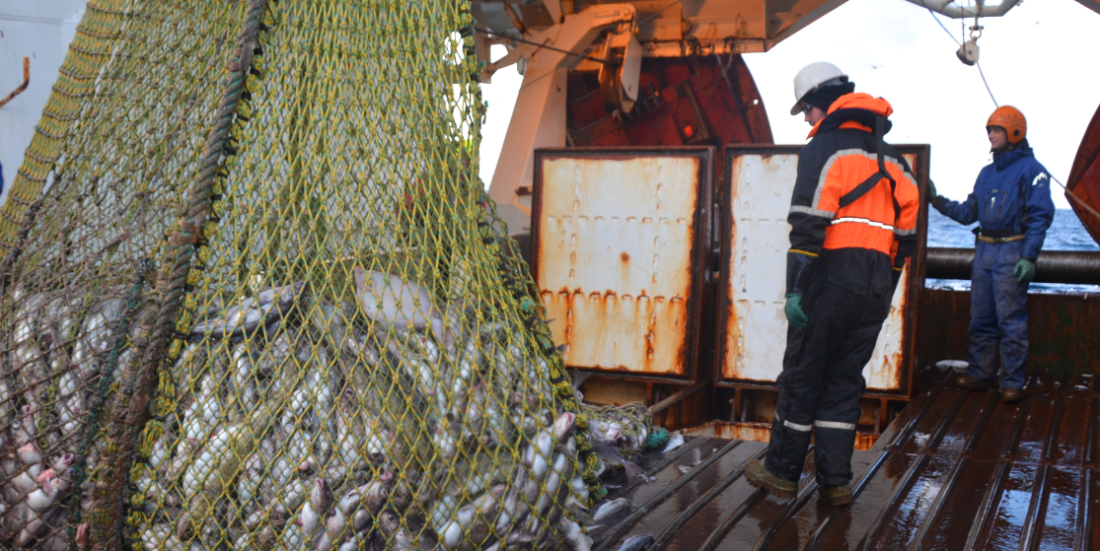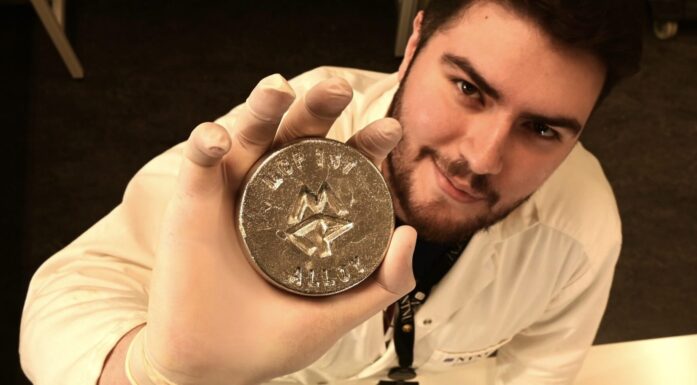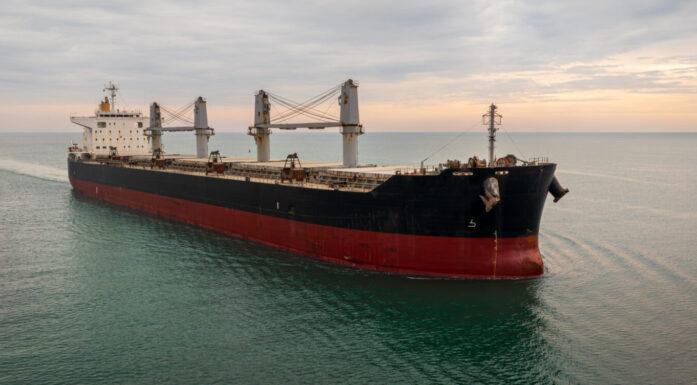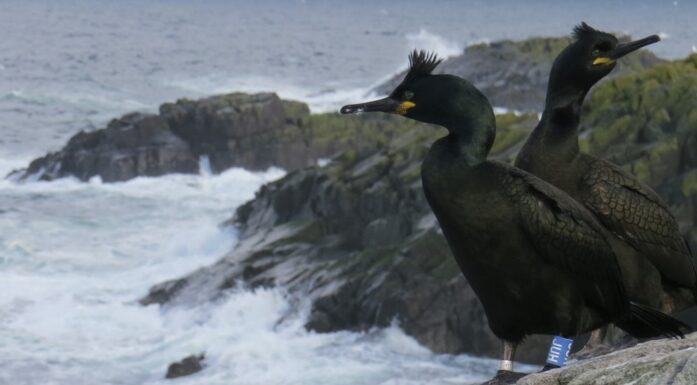Better fish welfare means better quality
More gentle methods of catching and gutting fish on trawlers will benefit the fish, the environment and the bottom line.
Just one of the huge number of cod flopping around in a dry receiving bin onboard a fishing vessel. Soon it will be on someone’s dinner table, but first it has to die.
The research cruises
During the research period, four cruises were carried out in the Barents Sea using the research trawler Helmer Hansen, which is owned by the University of Tromsø. The cruises were carried out over a four-year period during the months of November, February and March.
Experiments involved the testing of the electro-stunner (equipment produced by Seaside AS, STANSAS #1, Norway) and the live storage of fish in tanks supplied with oxygen (equipment produced by Melbusystems AS, Norway). Brain activity in fish was measured by an expert from the Netherlands, while SINTEF researchers were responsible for the technology used and the measurements of survival rates, stress levels and quality of the fish meat.
Fish behaviour was studied by researchers from NINA.
SINTEF also carried out logging of energy consumption during the cruises. The aim is to apply these data in the future development of more energy efficient trawling operations.
A short time ago it was as free as a bird – swimming in the Norwegian Sea and eating what it came across. Then it found itself in the trawl net and its fun came to an abrupt end. If it is one of the lucky ones, it will be gutted quickly and its suffering will be over. But more likely it will spend hours gasping for oxygen before its ordeal is over. Gutting the fish today is done manually and it is a lot of work for the fishermen.
But researchers want the trawl fisheries to learn from the salmon farming industry where the fish are kept in tanks filled with seawater supplied with oxygen, and are stunned before gutting.
More ethical, please
“When a trawler makes a huge catch it is in practice very difficult to treat the fish gently sensitively”, explains SINTEF researcher Hanne Digre. “Until now the industry has simply accepted that there was no alternative”, she says. Digre has been working with fish and their welfare since 1998.
However, she and her colleagues have been conducting experiments showing that it is both feasible and economically viable to improve the current practices. Because quality and price are closely linked, the welfare of the fish is also good news for the bottom line.
“In the end, it’s all about the better exploitation of our food resources”, says Digre. “And ensuring that as little as possible goes to waste. We’re living in a world where the population is increasing. Resources are becoming scarce – so we have to manage them better. And this means treating fish more gently because this in turn means less discards”, she says.
The SINTEF scientists have carried out several research cruises on trawlers in the Barents Sea, where they have obtained good results with experiments involving live storage and electro-stunning. This work has been part of a project called DANTEQ, which is looking into how it might be possible to fish more effectively – not only in relation to fish welfare and product quality, but also because consumers continue to make strict demands about how their food is produced.
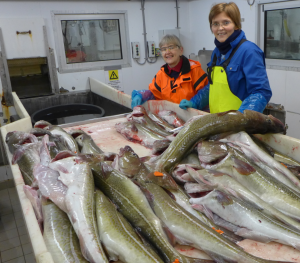
Researchers with some of the day’s catch, studying the quality of the fish. Project leader Hanne Digre to the right and engineer Marte Schei to the left. Photo: SINTEF
What’s in it for the cod?
For the cod, in centre stage of this drama, the technology has great benefits. Hans Van de Vis, from the Dutch Research Institute IMARES/Wageningen, has been conducting research into how the consciousness of a fish responds during the catch process, and whether or not stunning has any effect. Van de Vis is a specialist in fish welfare, and participated in the experiments carried out by researchers in the Barents Sea. He measured brain and heart activity in cod and haddock both before and after the fish had been subjected to electro-stunning.
The results from his measurements of electrical activity in the brain have been published in this article, Effects of on-board storage and electrical stunning of wild cod (Gadus morhua) and haddock (Melanogrammus aeglefinus) on brain and heart activity, and show that the fish are conscious for at least two hours after they have been brought on board and kept in the traditional dry bins.
However, fish that were stunned displayed no brain activity. The researchers thus concluded that we should be making every effort to stun and then gut the fish as quickly as possible since this will improve fish welfare onboard commercial fishing vessels.
Less stress – better quality fish
As well as investigations into fish brain and heart activity, SINTEF researchers also measured the levels of stress experienced by fish based on a series of indicators identified in their blood. Measurements were carried out on fish that had been kept in water-filled tanks supplied with oxygen for different periods of time.
Results showed that levels of stress remained approximately the same immediately after the catch and during most of the time that the fish spent in the tanks, but that there was a tendency for the fish to be more stressed during the first hours in the tanks.
However, when it came to quality, researchers identified differences between the fish that were kept in the water tanks supplied with oxygen compared to those in the dry bins.
“Both the studies carried out as part of this project and others demonstrate that fish that are alive when they are gutted display whiter flesh, which is something the consumers prefer”, says Digre. “So, if the fish are kept alive in water-filled tanks and supplied with oxygen, the chances of ending up with a product with whiter flesh is much greater than if they are kept in dry bins”, she says.
Benefits to the fishermen too
Stunning has been shown to be of benefit not only to the fish. Currently, it is common to gut fish manually. This is a cumbersome and hazardous job for the fishermen.
“Stunning the fish electrically before gutting will benefit both the fish and the fishermen”, says Digre. Today, it isn’t the safest task in the world trying to grasp a squirming fish in one hand while holding a sharp knife in the other”, she says, adding that fishermen have on occasion suffered fatal accidents while attempting to gut fish on vessels.
Stunning thus contributes to making the fisherman’s job easier and more efficient. It also results in better product quality because the fish can be gutted before their blood starts to coagulate. And the technology is easy to put to use.
“We believe that this project has provided us with satisfactory results and vital new know-how”, says Digre. “The electro-stunning equipment is easy to install and can be fitted above the conveyor belt onboard a trawler”, she says. “It is neither expensive nor difficult to operate, and has a major positive impact on the working environment, product quality and animal welfare. We observed that it works very well for cod and haddock, but that we had some problems when it came to saithe”, says Digre.
Research results
Short time live storage of fish before killing:
- When towing times are short and catches are small a survival of 50-80 % was found for cod (density of fish in the storage tank varied from 120 to 550 kg/m3)
- The water depth in which the fish are kept influences the survival rate – the shallower the water, the better the survival rate.
- Stress levels for the fish appeared to be lower immediately following the catch than after live residency in the tank.
- Less blood was found in fillets from live stored fish and fish processed straight after catch compared with those kept in dry bins prior to gutting and cleaning.
Electro-stunning of fish:
- Voltage of 40 V DC is enough to achieve satisfactory immobilizing and easier handling of catch in connection with further processing (bleeding/gutting/heading) for cod, haddock and saithe.
- Three rows of electrodes on the stunner (current load for 4 – 6 seconds) is enough to achieve satisfactory immobilization.
- Electrostunning of saithe lead to broken backbone and bloodspots on 10 to 40 % of the fish.
- , although the risk of broken backbones was less for stressed or exhausted fish (saithe) than for unstressed fish. Work is currently in progress to modify the electrical parameters of the electro-stunning equipment. For example, varying the frequency of the electrical pulse by alternating between high and low frequencies. It has previously been shown that there is a correlation between frequency and the tendency towards broken backbone in salmon.
The DANTEQ project:
The sustainable harvesting of wild fish is one of the most important challenges facing the global population in its efforts to obtain adequate fish volumes. There is a huge potential for improvement in the field of fish harvesting efficiency. The DANTEQ project has resulted in the development of new skills and methods for optimising fish handling onboard vessels in relation to raw materials quality and energy efficiency. Work linked to the DANTEQ project has been subdivided into four different fields:
The effects of short-term live storage of fish prior to gutting, and electro-stunning.
Onboard cooling and freezer systems and their effects on raw materials quality.
Logging of energy consumption from different sources onboard trawlers for data capture. The aim here is to apply these data in the development of more energy efficient vessel operations.
Development of mathematical models and approaches to the simulation of catch management and the factory processes carried out on board.
Priorities:
- To supplement the knowledge database linked to the relationships between harvesting, gutting and fish welfare, both from an ethical perspective, and in relation to quality and value adding.
- To further develop methods designed to avoid unintentional injury and unwanted deaths in the fisheries industry.
- To boost our know-how in the field of welfare linked to the interim storage of living fish and shellfish, and in connection with capture-based aquaculture.
Funding from the Research Council of Norway and The Norwegian Seafood Research Fund.
